#eggplant salad dish
Explore tagged Tumblr posts
Photo
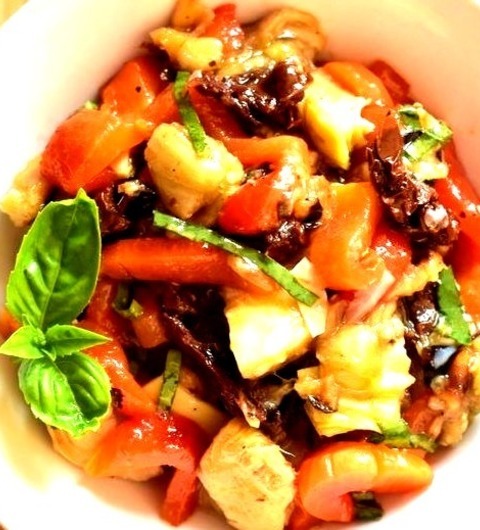
Roasted Eggplant and Red Bell Pepper Salad Roasted eggplant and bell peppers join sun-dried tomatoes and artichokes in this Italian-inspired salad.
#red#revisions#baking sheet#bell pepper salad recipe#bell pepper salad#eggplant salad dish#bell peppers
0 notes
Text
If you haven’t already, please vote! I’m curious to see what kind of potluck we’re having.
For this hypothetical, the drinks, plates, and dinnerware are already taken care of, and again, you're not allowed to turn up empty-handed.
Just like in real life, let's hope we won't choose to bring the same thing.
#food#polls#reblog#why did I include these dishes?#most of them are quick and relatively easy to prepare#I didn’t list additional desserts or deviled eggs because I know my audience#I know 40% of you would show up with eggs#again you can bring something else in addition#for every potluck I go to#I bring two dishes; something safe and something unexpected#my 'safe' dish is quinoa tabbouleh and my unexpected dish(es) are things like japchae and pork lettuce wraps or steam-fried tacos#once I made a tomato and eggplant shakshuka for a halloween party#people asked about it for months afterwards#every pasta salad I've made has been a banger
1K notes
·
View notes
Photo

Warm Eggplant Salad Recipe As a vegetarian appetizer, this lovely eggplant salad with red bell pepper and balsamic vinegar can be served warm.
0 notes
Photo

Mamma Annette's Caponatina Eggplant Salad Recipe This Sicilian eggplant salad is suitable as a light lunch or a side dish at dinner. It is made up of sauteed vegetables that have been simmered in a tomato and caper sauce and combined with briny olives. 1 bunch celery cut into 1/2-inch slices, 1 tablespoon white sugar, 1/4 cup capers rinsed, 2 medium onions sliced, 1 large eggplant cut into 1/2-inch cubes, 1 can tomato paste, 1 cup vegetable oil or as needed, 1/2 cup red wine vinegar, 1 can large black olives, 4 medium green bell peppers thinly sliced, salt to taste, 1 jar pimento-stuffed green olives
0 notes
Photo

Warm Eggplant Salad As a vegetarian appetizer, this lovely eggplant salad with red bell pepper and balsamic vinegar can be served warm.
0 notes
Text
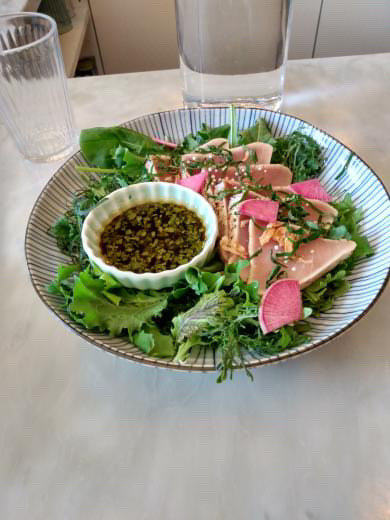
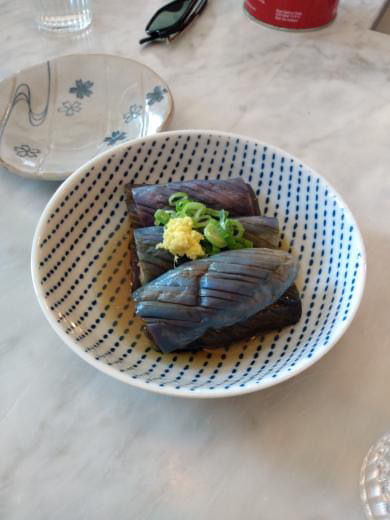
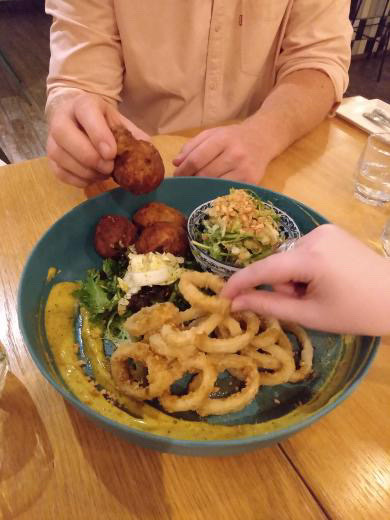

When your brothers a chef so he takes you for two of the best meals of your life! 🙌
#caribbean food like wow japanese food like wow#montreal has an amazing restaurant scene#the best eggplant dish ever up top right#right*#and johnny cakes with calamari and a papaya salad#oh my GOD#so good#seafood mac and cheese with jerk salmon wow
1 note
·
View note
Photo

Recipe for Ruth's Eggplant Caponata Caponata, a dish made of eggplant, garlic, tomatoes, herbs, and spices, is great as a side dish, salad, or relish. 1 pound Japanese or other small eggplant cut into 1/2-inch cubes, 1/2 teaspoon salt, 3 cloves garlic minced, 1 onion chopped, 1 teaspoon dried oregano, 2 tablespoons red wine vinegar, 3 tablespoons capers drained, 1 cup water, 1/2 teaspoon black pepper, 1/4 teaspoon ground allspice, 1 can fire-roasted diced tomatoes, 1/4 teaspoon ground cinnamon, 1/3 cup dry red wine, 1 bay leaf, 2 tablespoons white sugar, 2 tablespoons olive oil
1 note
·
View note
Photo

Simple Caprese Salad Recipe In a simple Italian salad that's perfect for a light main dish on a hot summer day, fresh slices of red ripe tomato alternate with mild mozzarella cheese and pieces of roasted red pepper.
0 notes
Photo
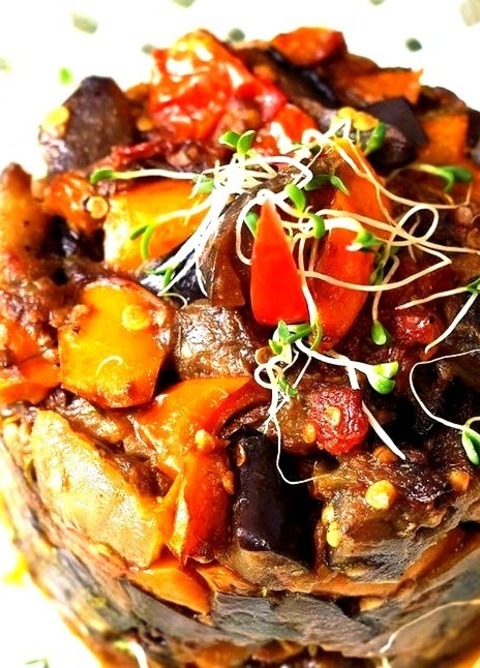
Roasted Eggplant and Bell Pepper Salad In the summer, this chilled salad of roasted peppers and eggplant makes a delicious antipasti or side dish to serve with toast or chips. It's ideal for gatherings.
0 notes
Photo

Vegetable Salad - Simple Caprese Salad Fresh slices of red ripe tomato alternate with mild mozzarella cheese and pieces of roasted red pepper in an easy Italian salad that's great for a light main dish on a hot summer day.
1 note
·
View note
Text
healthy lunch and dinner ideas
I thought I would share what I usually eat for lunch or dinner, it's easy and quick to make as well as healthy, you don't need many ingredients. If you like this post in the future I can do more about recipes.
1. TOAST


bread: bagel, seeded or protein bread ideas of ingredients to combine: avocado, light turkey, salmon, eggs (scrambled too) goat cheese, tomato, spinach, cucumber slices, chia seeds and a dash of olive oil.
2. BOWLS/SALADS


base: quinoa, rice or spinach ingredients to add: avocado, broccoli, tuna, chicken strips, tomato, cucumber slices, feta or goat cheese, tofu, chickpeas, boiled eggs, shrimps, olive oil and chia seeds (or the seeds that you like the most)
3. OMELETS


ingredients to add: turkey, spinach, mushrooms, goat cheese (or your choice)
spinach and feta omelet recipe
4. MORE IDEAS


sweet potato, pumpkin or oven-roasted eggplant to accompany any dish
pasta salad with tomato, rocket, spinach, cherry tomatoes, cheese, cheese and seeds of your choice
bowl of boiled vegetables (carrot, cauliflower, broccoli, peas, mushrooms)
chicken with boiled egg and rice garnish
(I clarify that the ingredients are ideas, not all are added, you can choose them.)
(all pictures are from pinterest to inspire the recipes but in the future I might share my own)
#that girl#green juice girl#self love#self esteem#levelup#self improvement#self worth#leveling up#pink pilates princess#level up journey#becoming that girl#becoming her#best version of yourself#live your best life#live your own life#live your dreams#healthy living#manifest#manifestation#high value mindset#high maintenance#high value woman#habits#self healing#healthy lifestyle#healthy tips#that girl aesthetic#mindset#healthy weight loss#healthy diet
412 notes
·
View notes
Text
PRIVATE LESSONS – Sanji x female reader

Summary: on what is supposed to be another of your private cooking lessons, you and Sanji get closer... in a very intimate way.
Pairing: Sanji x female reader.
Word count: 2k.
Warnings: pure fucking, dirty, obscene fingerfucking smut, some plot, heavy hand kink, eye contact, language (also reader thinks herself as a slut at some point), fingering, cum play(?), semi-public, praising, pet names (darling, sweetheart, good girl...).
Notes: this is just full of smut so yeah. Idk, this is my realization that I am a Sanji whore. Enjoy you sinners. And I'm sorry for any errors as English is not my main language. (I'll keep apologizing for this lol).
☕ if you like my writing, support me with a ko-fi !
Probably will make a part 2 to consumate this shit, but I can't promise I will...
GEN MASTERLIST!

Months ago, you started at the Baratie as a waitress but your biggest wish was cooking. And Sanji was there to help you with that. You had absolutely no idea how to start, lucky for you, the blonde chef of the restaurant was aware of your dreams. So you started lessons after your shift.
"Can't deny the wishes of a pretty thing like you," you remembered Sanji saying when you finally asked him to teach you. He winked and put a playful smirk on his lips.
Yes, Sanji was a flirt - but he was a flirt with everyone. So you never took personally his random comments and hits, until you started your cooking classes.
The Baratie was always closed and there was no one but Sanji and you in the kitchen. He had started with the basic stuff, like chopping vegetables and soft meat, and making easy entries and sidedishes.
There was a problem though. This was almost the fourth week you were receiving his lessons and you found out there was something distracting you a lot recently: his hands.
His beautiful, strong hands, that, in a delicate manner, would slice a fish and would convert it in the most delicious dish you ever tasted ever. You became so immersed in his hands doing little to nothing. Even if Sanji wasn't cooking, just fixing his hair or having a cigarrette, everything you could keep your focus on was his beautiful fingers, sometimes wearing pretty rings and jewels around them. And the way the veins on his big hands would appear... Gods, your mind started to wonder a lot of things and it was becoming difficult keeping your focus on the special salad you were preparing that night.
"You're doing great, love," Sanji whispered, staying right behind you and monitoring carefully your chopping like an inspector.
His sweet words were no help for you at all. With a deep breath, you finished with the last eggplant. Sanji immediately came closer and leaned behind your back, and you controled the loud gasp that was about to burst. You felt his strong body pressed against your own, and he suddenly grabbed your hand still holding the knife to start chopping a small piece of the eggplant you just finished. His arms were now sorrounding your figure as he guided softly on how you were supposed to cut it.
"Just make sure to cut them like this, see?"
All you could give was a nod. Fuck, you felt so embarrassed, hypnotized by his hands working on the must mundane activities in the whole world, grabbing firmly the knife between his fingers.
Those thick fingers you fantasized about late at night; not letting you pay attention to the important things Sanji would say to you about cooking. Those fingers you wished to have inside you right now, to lick them, to suck on them until they were completely dry... You rub your thighs together and try to keep your thoughts locked to continue with the lesson.
"Yeah, I see now. Thanks, Sanji," you were surprised you were actually able to talk.
You heard his chuckle behind you before shifting and come by your side, leaving you free of his grip and the warmth of his hands that you were already missing.
"Lets plate then."
Sanji guided you on how to place each ingredient on the bowl, making it harder for you to follow his pace. It took longer than you expected, but you were trying to keep your shit together; your skirt and shirt suddenly felt too tight on your figure and you tried to not rub your thighs, even if you wished for some friction right now.
Once the bowl was done, Sanji took the small plate with the sauce you prepared earlier and gave it a delicate taste, licking the spoon with his tongue.
Why did he look so hot just by doing anything? Was he aware of the effect he had in you lately? Was he teasing you? Or where you just hot and bothered already? No answer you had for any of those questions.
Sanji wrinkled his brows, savoring the sauce with such delicacy, and after a moment or so of thinking he looked at you.
"I think something is missing," he said.
"What? I put everything that was on the recipe for the sauce." In a swift move, you took the spoon from his hand and had a taste yourself. "Seems okay for me."
The chef tsked. "Darling, you need to taste it differently. Deeper, go further than usual."
Sanji dipped his forefinger on the sauce and brought it to your lips. With hesitation, you opened your mouth and licked the sauce from his finger, not only tasting the sauce but savouring the moment. Was he aware of how you looked at his hands? You were not going to question it. Not when you carefully wrapped your soft lips around him, closing your eyes slowly, arousal building up between your legs. His words were no help either, it was like if he was testing the waters and so were you.
You felt Sanji pulling out his finger from your mouth and you let out a soft moan. You wanted to snap yourself. He smirked, he obviously heard your pretty noise.
"Sorry..." you were ashamed but the burning desire was growing and winning over you. What a fucking slut, you thought to yourself. It didn't matter right now. You just had a taste of his fingers.
"So what'd you say?" Sanji interrupted the voice inside your head.
Your dark eyes looked intensely his charming blue ones. "I still think the taste is good."
Sanji leaned down, almost brushing your lips and looking like if he was forcing himself to not press his lips to yours right there and then. Until he did. He captured your lips in a heated and rough kiss, his tongue finding its way into your mouth and tasting the sauce and the sweetness of your plump lips. One of his hands cupped your cheek and the other pulled you closer, forcing your back to press against the counter. Now, you were trapped between his body and the surface.
A moan escaped your throat and Sanji happily swallowed it on the heated make out session you shared. He lifted you up so you were sitting on the empty side of the counter, taking shallow breaths, as he stood between your parted legs, stroking the skin of your thighs without any rush.
"I've noticed you look at my hands so attentively," he mumbled, biting your lower lip softly. You gasped, but he continued. "Why's that?"
His question left you speechless for a moment. Did he really need to ask?
"Sanji, I already licked your finger..."
His palms traced their way under your skirt, and his fingers teased your inner thighs, finding the fabric covering your wet core.
"Well, darling, doesn't that mean we can go further? Deeper?"
"Go ahead then," you mumbled, full of lust. Your skin was aching already for him and this was all you needed to feel complete. Him.
With that, his fingers rubbed you softly over your panties, pressing on the wet patch you were already making. Sanji smirked and he leaned to pay attention to the delicate skin on your neck. His lips pressed soft kisses, leaving a trail of them, until he found the sweet spot that made you melt into his touch, nibbling and sliding his tongue against your neck until he met your collarbone.
"Sanji..." the soft whimper past your lips and you held your breath, eyes closed as he hiked up your uniform skirt and puts aside the panties covering your core from him.
His name falling off your lips made his cock inside his trousers twitch, restraining himself to not fuck you right there in the counter until the only thing that was on your mind was his name and only him. Right now, he decided he would take care of you first. As you deserved it.
"So fucking wet for me, sweetheart," he groaned, forehead pressing against yours.
His fingers found your pussy, spreading your folds softly, coating them with your already dripping juices. Sanji rubbed your clit and he teased your entrance, going at an agonizing rhythm. All you wanted was for him to fuck you with his fingers. Now. You started to grind your hips, needing some more friction, knowing he would get the hint of your despair.
"Please, Sanji," you whined.
Sanji chuckled, and you felt pathetic for begging. You could tell he was enjoying your squirm. His free hand cupped the nape of your neck forcing your dark eyes to look at his own directly.
"Look at me," Sanji ordered. "Do not dare to close your eyes, darling."
You bit your lip and nodded, gripping tightly the edge of the counter.
"Good girl," he whispered with a raspy voice, and with a lustful smile on his lips. "I want to see you come undone."
And with his statement, he eased one digit inside your velvety walls. You moaned louder this time.
"Fuck, you're so ready for me," Sanji growled, noticing how obvious the ache between your thighs was. "You're perfect, darling," he cooed against your lips. His praising caused your walls to clench around him, gaining another dark smile from the blonde man.
The thrusts of his finger started in a delicate pace. Instantly, your eyes clenched, breath hitching, as he filled you up. Sanji gradually increased his pace, curling his finger to reach your deepest spot, and you felt your juices coating your thighs with his moves.
"You look at me, don't forget," Sanji whispered, his other hand now cupping your cheek. You obeyed, opening your eyes for him.
A second finger made its way inside your cunt and he pumped them harder this time. Your legs were spreading wider, moaning against his lips, dying to kiss him one more time. But you tried your hardest to mantain the deep eye contact, realizing where you were right now. In the empty kitchen of the Baratie, with the blonde chef between your legs, fucking you with his pretty fingers. Those he protected and took care of so attentively.
And now, the only place Sanji wanted to have his fingers on was inside of you. You looked flushed, sweaty and simply gorgeous, cyring and whimpering. All for him. Your pussy was throbbing and you let a rather loud and erotic moan.
"Shit, I'm so close," you cried.
"Just come for me, beautiful..."
His lips catching your swollen ones in a heated kiss. He curled up his fingers, thumb rubbing your clit softly. Your hips trying to meet the thrusts of his hand desperately, your smooth walls clenching around his digits. Sanji realized he enjoyed the control and power he had over you as you reached your heavenly climax. He loved it more than he could ever think of.
Your body trembled, and finally, you felt sweet release hitting you, walls spasming in ecstasy around his fingers. Foreheads still touching, eyes locked as he watched you come undone. Exactly like he wanted it to be.
You moaned his name under your breath over and over, filled with pleassure. Sanji felt your thighs closing and your pussy contracting around his digits. He let you catch your breath for a moment, enjoying the heat of your body. For the first time, Sanji then pulled away his forehead, remaining still between your legs, and slowly removing his fingers from your throbbing cunt, eyes looking directly to your wetness.
Still covered with your juices, Sanji used both his hands to spread your folds obscenely to get a better look at your pussyhole. Fuck, you felt so exposed to him, but you couldn't care less. You had a mindblowing orgasm just moments ago.
"Fuck-" you cried.
"So beautiful," he praised. Again, you whimpered and your hips bucked a little.
Sanji pushed a finger slowly inside you, just to gather more of your sweetness, so he could finally have a taste. He licked both fingers he used on you before, humming like he had found the best meal in days.
"So how is it?" you finally asked, teasing him.
"Sweetheart, you're delicious."
You laughed softly, realising you totally forgot about the dish you were preparing that night. "Is this included on your private lessons, Sanji?"
"Only if you want," he leaned down to share a last kiss, this time more gentle than the others.
He already knew your answer.

#opla sanji x reader#opla sanji smut#opla sanji#opla sanji x female reader#op!la sanji x reader#op!la sanji x female reader#op!la sanji smut#one piece sanji live action#sanji x female reader#sanji x reader#sanji smut#one piece netflix#one piece sanji one shot#one piece live action fanfiction
3K notes
·
View notes
Text
Mafrum is a Jewish Libyan dish of potato stuffed with spiced ground beef, then simmered in a tomato sauce. It is traditionally eaten on Shabbat and Jewish holidays.
The Libyan kitchen is a mix of Arabic and Mediterranean food, with a strong Italian influence. But since the early 1950s, when the vast majority of Libyan Jews immigrated to Israel, mafrum has evolved. It quickly became very popular in Israel, where it has been interpreted by Jews from different countries, such as Tunisia, Morocco and even Egypt.
I grew up on this dish. My late grandmother used to make it for holidays and it’s one of my family’s favorite dishes for Shabbat. My mom serves it over couscous with a side of tahini sauce and a finely chopped vegetable salad.
My interpretation of mafrum is a little bit different, mostly because in the original recipe you only use tomato paste for the sauce. I love fresh tomatoes, which is why I use them as a base for my sauce. They make the sauce a bit richer, and put a new spin on it. Sometimes, to make the dish a little lighter, I replace the traditional potato with eggplant, which is my favorite vegetable. But it is the potato version that I want to cook and eat on cold winter nights. I serve it the same way my mom does: the tahini sauce is perfect, the salad brings freshness, and if you squeeze fresh lemon on top of it all, you’re basically in heaven.
192 notes
·
View notes
Note
hi jude due to recent allergy things im having to change up my diet a lot. do you have any vegan/vegetarian recipe suggestions? ty💕
Hi! I’m sorry to hear about your recent allergies, that’s really tough.
My biggest advice when starting cooking vegan or vegetarian is to learn how to season correctly to bring out savory notes. Of course, standard spices as well but things like liquid smoke, nutritional yeast, not-chicken or not-beef (literally what they are called) buillon, msg and umami/shitake mushroom flavoring are used so frequently in my cooking you don’t even know. Other staples to invest in are shelf stable silken tofu (which can be eaten raw, cooked in a variety of soups and dishes, mashed into a meat subsitute and used to make fake meatballs or veggie burgers etc.., or blended into pasta sauce to make it creamy), coconut milk (good for pasta sauce, curry, desserts, anything you need to make creamy), miso and tahini (can enhance vegetables, good for boosting flavors) and canned beans (i love butter beans and cannalini beans, but any work of course. just a really solid protein option that’s easy enough to make taste really good.)
The goal with this type of cooking is to always consider your protein source first. I’m vegetarian, so I often also base things around eggs or cheese- but there are so many vegan protein source options out there. seitan, tempeh (my personal fave lol) and tofu are like your trilogy that most things are based out of. and of course there are things like beans and peanut butter that can help you get your protein up as well.
Okay i’m gonna link some videos i like now lol. I get a lot of recipes from tiktok because. idk i do. these are also kiiiinda fancy
beans alla vodka (vegetarian)
peach and burratta salad (vegetarian)
miso tahini eggplant (vegan)
miso braised cabbage (vegan)
hot honey brown butter brussel sprouts (vegetarian)
tofu scramble (vegan)
tempeh marinade (vegan)
80 notes
·
View notes
Text
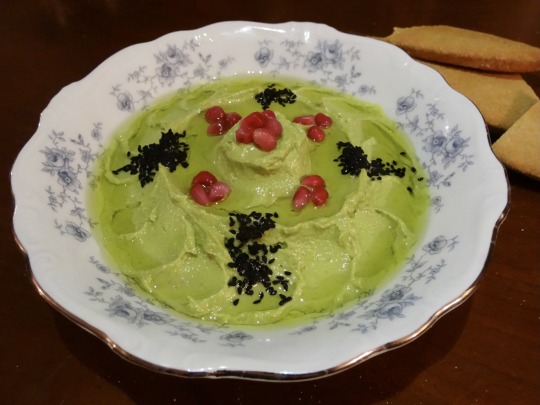
[ID: A bowl of avocado spread sculpted into a pattern, topped with olive oil and garnished with symmetrical lines of nigella seeds and piles of pomegranate seeds; a pile of pita bread is in the background. End ID]
متبل الأفوكادو / Mutabbal al-'afukadu (Palestinian avocado dip)
Avocados are not native to Palestine. Israeli settlers planted them in Gaza in the 1980s, before being evicted when Israel evacuated all its settlements in Gaza in 2005. The avocados, however, remained, and Gazans continued to cultivate them for their fall and winter harvest. Avocados have been folded into the repertoire of a "new" Palestinian cuisine, as Gazans and other Palestinians have found ways to interpret them.
Palestinians may add local ingredients to dishes traditionally featuring avocado (such as Palestinian guacamole, "جواكامولي فلسطيني" or "غواكامولي فلسطيني"), or use avocado in Palestinian dishes that typically use other vegetables (pickling them, for example, or adding them to salads alongside tomato and cucumber).
Another dish in this latter category is حمص الافوكادو (hummus al-'afukadu)—avocado hummus—in which avocado is smoothly blended with lemon juice, white tahina (طحينة البيضاء, tahina al-bayda'), salt, and olive oil. Yet another is متبّل الأفوكادو (mutabbal al-'afukadu). Mutabbal is a spiced version of بابا غنوج (baba ghannouj): "مُتَبَّل" means "spiced" or "seasoned," from "مُ" "mu-," a participlizing prefix, + "تَبَّلَ" "tabbala," "to have spices added to." Here, fresh avocado replaces the roasted eggplant usually used to make this smooth dip; it is mixed with green chili pepper, lemon juice, garlic, white tahina, sumac, and labna (لبنة) or yoghurt. Either of these dishes may be topped with sesame or nigella seeds, pomegranate seeds, fresh dill, or chopped nuts, and eaten with sliced and toasted flatbread.
Avocados' history in Palestine precedes their introduction to Gaza. They were originally planted in 1908 by a French order of monks, but these trees have not survived. It was after the Balfour Declaration of 1917 (in which Britain, having been promised colonial control of Palestine with the dissolution of the Ottoman Empire after World War 1, pledged to establish "a national home for the Jewish people" in Palestine) that avocado agriculture began to take root.
In the 1920s, 30s, and 40s, encouraged by Britain, Jewish Europeans began to immigrate to Palestine in greater numbers and establish agricultural settlements (leaving an estimated 29.4% of peasant farming families without land by 1929). Seeds and seedlings from several varieties of avocado were introduced from California by private companies, research stations, and governmental bodies (including Mikveh Israel, a school which provided settlers with agricultural training). In these years, prices were too high for Palestinian buyers, and quantities were too low for export.
It wasn't until after the beginning of the Nakba (the ethnic cleansing of Palestinians from "Jewish" areas following the UN partition of Palestine in 1947) that avocado plantings became significant. With Palestinians having been violently expelled from most of the area's arable land, settlers were free to plant avocados en masse for export, aided (until 1960) by long-term, low-interest loans from the Israeli government. The 400 acres planted within Israel's claimed borders in 1955 ballooned to 2,000 acres in 1965, then 9,000 by 1975, and over 17,000 by 1997. By 1986, Israel was producing enough avocados to want to renegotiate trade agreements with Europe in light of the increase.
Israeli companies also attained commercial success selling avocados planted on settlements within the West Bank. As of 2014, an estimated 4.5% of Israeli avocado exports were grown in the occupied Jordan Valley alone (though data about crops grown in illegal settlements is of course difficult to obtain). These crops were often tended by Palestinian workers, including children, in inhumane conditions and at starvation wages. Despite a European Union order to specify the origin of such produce as "territories occupied by Israel since 1967," it is often simply marked "Israel." Several grocery stores across Europe, including Carrefour, Lidl, Dunnes Stores, and Aldi, even falsified provenance information on avocados and other fruits in order to circumvent consumer boycotts of goods produced in Israel altogether—claiming, for example, that they were from Morocco or Cyprus.
Meanwhile, while expanding its own production of avocados, Israel was directing, limiting, and destabilizing Palestinian agriculture in an attempt to eliminate competition. In 1982, Israel prohibited the planting of fruit trees without first obtaining permission from military authorities; in practice, this resulted in Palestinians (in Gaza and the West Bank) being entirely barred from planting new mango and avocado trees, even to replace old, unproductive ones.
Conditions worsened in the years following the second intifada. Between September of 2000 and September of 2003, Israeli military forces destroyed wells, pumps, and an estimated 85% of the agricultural land in al-Sayafa, northern Gaza, where farmers had been using irrigation systems and greenhouses to grow fruits including citrus, apricots, and avocados. They barred almost all travel into and out of al-Sayafa: blocking off all roads that lead to the area, building barricades topped with barbed wire, preventing entry within 150 meters of the barricade under threat of gunfire, and opening crossings only at limited times of day and only for specific people, if at all.
A July 2001 prohibition on Palestinian vehicles within al-Sayafa further slashed agricultural production, forcing farmers to rely on donkeys and hand carts to tend their fields and to transport produce across the crossing. If the crossing happened to be closed, or the carts could not transport all the produce in time, fruits and vegetables would sit waiting in the sun until they rotted and could not be sold. The 2007 blockade worsened Gaza's economy still further, strictly limiting imports and prohibiting exports entirely (though later on, there would be exceptions made for small quantities of specific crops).
In the following years, Israel allowed imports of food items into Gaza not exceeding the bare minimum for basic sustenance, based on an estimation of the caloric needs of its inhabitants. Permitted (apples, bananas, persimmons, flour) and banned items for import (avocados, dates, grapes) were ostensibly based on "necessary" versus "luxury" foods, but were in fact directed according to where Israeli farmers could expect the most profit.
Though most of the imports admitted into Gaza continued to come from Israel, Gazan farmers kept pursuing self-sufficiency. In 2011, farmers working on a Hamas-government-led project in the former settlements produced avocados, mangoes, and most of the grapes, onions, and melons that Gazans ate; by 2015, though still forbidden from exporting excess, they were self-sufficient in the production of crops including onions, watermelon, cantaloupe, grapes, almonds, olives, and apples.
Support Palestinian resistance by calling Elbit System’s (Israel’s primary weapons manufacturer) landlord, donating to Palestine Action’s bail fund, and donating to the Bay Area Anti-Repression Committee bail fund.
Ingredients:
2 medium avocados (300g total)
1/4 cup white tahina
2 Tbsp labna (لبنة), or yoghurt (laban, لبن رايب)
1 green chili pepper
2 cloves garlic
2 Tbsp good olive oil
Juice of 1/2 lemon (1 1/2 Tbsp)
1 tsp table salt, or to taste
Pomegranate seeds, slivered almonds, pine nuts, chopped dill, nigella seeds, sesame seeds, sumac, and/or olive oil, to serve
Khubiz al-kmaj (pita bread), to serve
Instructions:
1. In a mortar and pestle, crush garlic, pepper, and a bit of salt into a fine paste.
2. Add avocados and mash to desired texture. Stir in tahina, labna, olive oil, lemon juice, and additional salt.
You can also combine all ingredients in a blender or food processor.
3. Top with a generous drizzle of olive oil. Add toppings, as desired.
4. Cut pita into small rectangles or triangles and separate one half from the other (along where the pocket is). Toast in the oven, or in a large, dry skillet, stirring occasionally, until golden brown. Serve dip alongside toasted pita chips.
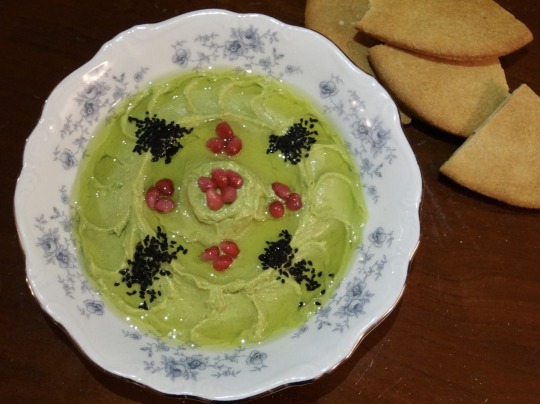
490 notes
·
View notes
Text
How to follow a Mediterranean Greek diet
The Mediterranean diet naturally expands throughout the coastal countries of South Europe, North Africa and the Middle East but there are some small differences between their cuisines. So here I am writing specifically about the Greek version of the Mediterranean diet, known for its delicious, natural flavours and its significant health benefits.

Eat daily:
Olive oil: the pillar, the liquid green gold of the Mediterranean Greek diet. Olive oil should be used ideally exclusively for all purposes. It's dressing salads, it's used in cooking and in fact it's traditionally what is used in frying too. Replace all types of oils, butter and margarine with olive oil even when making pastries. The only problem here is that outside of the Mediterranean basin olive oil can be pricey, however that's the foundation the diet is based on. If you are interested in following the traditional Greek diet for taste or health purposes, it is good to really incorporate olive oil in your daily cooking. If it’s not possible to afford buying olive oil all the time (although you could balance it out by not buying other oils and butter), a non-Greek-typical but equivalent alternative could be avocado oil. However, I doubt avocado oil or any other oil can remotely compare to olive oil in health properties, taste or in any other positive quality 🫒
Vinegar: Just like olive oil, vinegar is a very important ingredient and is also used in natural remedies However, it can hurt a sensitive GI tract if consumed in large portions. A little bit of it added to meals frequently is very healthy. Apple cider vinegar is also very loved and used in salads often 🍇
Vegetables: no portion can be too much (wild greens, garlic, onions, cauliflowers, cucumbers, eggplants, beets, peppers, spinach, artichokes, zucchini, peas, lettuce, the list never ends). Tomatoes and broccoli are recent additions to the Greek diet however they were integrated perfectly to the Greek cuisine. In general, all vegetables can be enjoyed freely with some moderation in the potatoes, especially when fried 🥗
Fruits: grapes, berries, apples, melons, cherries, figs, prunes, sour cherries, peaches, pomegranates are the most historically loved fruits in the Greek diet. Since the middle ages citruses like the orange, the lemon and the mandarin are more and more loved. Greeks nowadays use lemon almost more than vinegar and both have become integral components of the Greek diet. Obviously, tropical fruits like, say, banana, mango, grapefruit are not present in the traditional Greek diet, however all fruits are good fruits and you can enjoy them freely 🍎
Legumes. Eat freely to the tolerance of your body. Legumes can be too heavy for some GI tracts. Legumes are a great source of protein and fibre. Choose brown lentils, white beans, fava beans, chickpeas, giant beans and black eyed peas the most 🫘
Nuts, seeds: almonds, walnuts, sunflower seeds, peanuts etc. Eat as much as your body can take, because everybody is different 🥜
Mushrooms: mushroom it up! A great healthy way to have them is grilled with herbs and plain or apple cider vinegar dressing 🍄🟫
Whole grains: this is the traditional way to eat grains. Brown bread, oats, whole wheat pasta 🌾
Fish and seafood: find and eat them fresh. Instead of buying them deep frozen from the big markets, find local fish stores if your place is coastal and has them. Eat both large but especially small and medium sized fish. Some fish like salmon and tuna should ideally not be consumed daily due to their high levels of mercury and fats 🐟🎣🍤
Herbs and spices. Feel free to use as much as you want however if you are interested also in the flavours of the Greek diet besides the health benefits, a tip is that Greek dishes do not contain extremely hot spices 🌿
Water: A lot of water daily and, mind you, plain clear mineral water. No flavoured water, definitely not sparkling water and ideally no other liquids in place of the water. I mean, sure you can have liquids but you should ALSO have plain water 💧
Eat a few times per week:
Poultry: Poultry and lean meats entered the Greek cuisine mostly after the Middle Ages however they are nowadays enjoyed as part of the Greek Mediterranean diet because they are tasty and healthier than other types of meat. Chicken has become especially popular in the Greek cuisine. Other birds are the pheasant, the quail, the turkey and more sparsely the duck 🍗
Eggs: eggs are healthy and should be consumed a few times per week but not daily because they can cause a rise in cholesterol levels 🥚
Dairy: Greeks LOVE dairy products, especially the various types of cheese, however they are often irritating to the GI tract and they are linked with rises in the level of inflammation in the body. This is why you should ideally limit them to a few times per week. One exception is the yoghurt, which is fermented and can be perhaps consumed more frequently due to its beneficial properties. Important note: if you want to follow the Greek diet, you should ideally opt for milk and other dairy products from goats and sheep! Cow milk is not traditionally used in the Greek cuisine often and sheep and goat milk are significantly healthier and more nutritious. The only drawback is the stronger smell, however if you can get past that, it is strongly advised to switch to those instead of cow milk. Another note: what is known as “Greek yoghurt” in western countries is not in fact a true Greek yoghurt. What you call Greek yoghurt is to us simply a strained yoghurt, a yoghurt from which the whey has been removed. Sometimes in western markets (and in Greek “modern” dessert yoghurt products) butterfat and powdermilk is added to them and they are mostly made of cow’s milk. Again, a traditional Greek yoghurt is made of sheep, goat milk or a mix of both and is unstrained. It also has a trademark thickened skin on its top (dunno if this is the actual term lol) which is in fact the part of the yoghurt that contains the most nutrients and personally it’s the tastiest part of the yoghurt but apparently it is not for everyone. As an example, a study showed that an unstrained sheep yoghurt has more protein, more omega-3 fatty acids and minerals yet fewer calories and fats than a strained cow yoghurt 🍦🧀
Wine: in small portions, like a small glass up to a few times per week and always in combination with your meal. You don’t drink it to get hammered, you drink it for the health benefits it has in very moderate quantities and for the reasonable mild euphoria it causes before it becomes harmful. The GI tract is linked to the brain and is detrimentally influenced by negative emotions. This is why it is important to try to be in a good mood, relaxed and peaceful when you sit down to eat. A sip of wine now and then can be good for that 🍷
Eat once per week or ideally less:
Red meat like pork or beef. In fact, beef should be the one most avoided not only because it is indeed the rarest of the common meats used in traditional Greek cuisine but also because you can’t separate the fat from the meat as easily as with pork. To follow the Greek style in a healthy way opt for goat, then lamb or pork and make beef your most occasional meat dish 🥩
Processed meats should be eaten rarely. If you are in a mood for it though, opt for Greek style sausages with herbs in or bacon at most. Cured meats like ham are better to be avoided but turkey is the healthiest of them. They are not a part of a traditional Greek cuisine though.
Refined grains can be enjoyed weekly but should not replace whole grains
Pastries. What’s new, pastries are not ideal for health. However, if you are yearning for something sweet, if you want to keep it healthy as much as possible in the “Greek way”, opt for desserts made of healthy ingredients like honey, nuts, olive oil and fruits. Chocolate came to Greece in the 19th century, however it has become an integral part of confectionery since then. Opt ideally for dark chocolate, combined with nuts or fruits such as oranges and prunes. Greeks especially love chocolate combined with nuts.
Soft and sugary drinks. Avoid them overall, especially the processed products in the markets. If you need a sweet drink really bad, you can keep it traditional by making your own sweet lemonade, sour cherry, pomegranate etc drink at home. You could also enjoy small quantities of lemon or mastic liquors which are good for digestion.
BONUS TIPS & PHILOSOPHY:
Try to find mastic if it’s available where you live. The mastic is a resin produced from the mastic tree, a species endemic to the Greek island of Chios and a small part of the opposite coast of Turkey. It has numerous beneficial properties, especially for digestion and gut health, and it combines them with a very pleasant fresh and sweet flavour. You can find it in gums that boost digestion, in drinks, in pastries and even in non-edible products like toothpastes. Learn about it and give it a try, no matter if you are interested in following Greek diet or not.
Greek cuisine does not go berserk on as many ingredients as possible (however Greeks typically add more ingredients than, say, Italians and perhaps fewer than the Middle Easterners). Don’t worry about adding as many foods and nutrients in one single dish. The most important thing in Greek cuisine philosophy is to pick the finest ingredients. Avoid deep frozen or precooked and processed ingredients. Pick whole fruits and vegetables from your local small grocery store. For example, don’t buy a watermelon slice in a zelatin bag from the supermarket. Take the whole freaking watermelon home. You heard me right. It’s heavy, yes, but you would be surprised how much tastier and healthier it is this way. Go to the butcher for meat. Go to the specific cheese shop for cheese. Go to the fisherman for fish and seafood. Go to the pastry shop and get a nice dessert instead of buying candies from the market.
Remember that in moderation you can eat most of the foods you desire, especially if they are not processed foods. There is nothing about the Greek diet that is restrictive in terms of its philosophy - historically the intake of various foods was regulated only based on availability and price. There are no foods you should limit due to any perception of them being “bad” and you should never feel guilty the moment you are actually having the food. Just work slowly and progressively by building gradual appreciation for healthy foods and prize less nutritious foods as occasional taste bud rewards.
As said above, a good mood is crucial when you sit down to eat. In the history of the Greek society this translated into eating with friends and / or family, maybe with the occasional sip of wine, ideally in a pleasant environment and always taking your time with your food. If some of these are less feasible than others, try alternatively to improve the setting in which you eat, to eat in an environment that calms you down. Schedule your meal so that you won’t eat in anxiety or hurry, if this is possible. Think of pleasant memories and feel grateful for your food. Cheers! Or, you know, εις υγείαν!
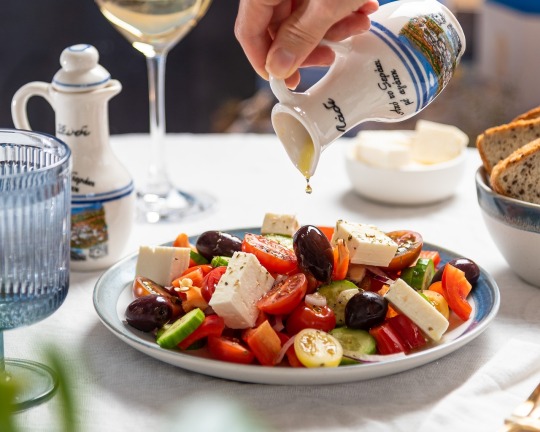
101 notes
·
View notes